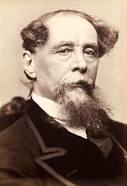Capital Punishment Page #4
"Capital Punishment" is not a direct title by Charles Dickens; however, themes surrounding capital punishment can be found in his works, particularly in "Oliver Twist" and "A Tale of Two Cities." In these novels, Dickens explores the moral implications of the death penalty, societal injustices, and the impact of crime and punishment on individuals and society. Through his vivid characters and compelling narratives, Dickens critiques the legal system of his time and advocates for social reform, emphasizing compassion and redemption over harsh retribution.
universally avoided, like a pestilence. I want to know why so much sympathy is expended on the man who kills another in the vehemence of his own bad passions, and why the man who kills him in the name of the law is shunned and fled from? Is it because the murderer is going to die? Then by no means put him to death. Is it because the hangman executes a law, which, when they once come near it face to face, all men instinctively revolt from? Then by all means change it. There is, there can be, no prevention in such a law. It may be urged that Public Executions are not intended for the benefit of those dregs of society who habitually attend them. This is an absurdity, to which the obvious answer is, So much the worse. If they be not considered with reference to that class of persons, comprehending a great host of criminals in various stages of development, they ought to be, and must be. To lose sight of that consideration is to be irrational, unjust, and cruel. All other punishments are especially devised, with a reference to the rooted habits, propensities, and antipathies of criminals. And shall it be said, out of Bedlam, that this last punishment of all is alone to be made an exception from the rule, even where it is shown to be a means of propagating vice and crime? But there may be people who do not attend executions, to whom the general fame and rumour of such scenes is an example, and a means of deterring from crime. Who are they? We have seen that around Capital Punishment there lingers a fascination, urging weak and bad people towards it, and imparting an interest to details connected with it, and with malefactors awaiting it or suffering it, which even good and well-disposed people cannot withstand. We know that last-dying speeches and Newgate calendars are the favourite literature of very low intellects. The gallows is not appealed to as an example in the instruction of youth (unless they are training for it); nor are there condensed accounts of celebrated executions for the use of national schools. There is a story in an old spelling-book of a certain Don’t Care who was hanged at last, but it is not understood to have had any remarkable effect on crimes or executions in the generation to which it belonged, and with which it has passed away. Hogarth’s idle apprentice is hanged; but the whole scene—with the unmistakable stout lady, drunk and pious, in the cast; the quarrelling, blasphemy, lewdness, and uproar; Tiddy Doll vending his gingerbread, and the boys picking his pocket—is a bitter satire on the great example; as efficient then, as now. Is it efficient to prevent crime? The parliamentary returns demonstrate that it is not. I was engaged in making some extracts from these documents, when I found them so well abstracted in one of the papers published by the committee on this subject established at Aylesbury last year, by the humane exertions of Lord Nugent, that I am glad to quote the general results from its pages: “In 1843 a return was laid on the table of the House of the commitments and executions for murder in England and Wales during the thirty years ending with December 1842, divided into five periods of six years each. It shows that in the last six years, from 1836 to 1842, during which there were only 50 executions, the commitments for murder were fewer by 61 than in the six years preceding with 74 executions; fewer by 63 than in the six years ending 1830 with 75 executions; fewer by 56 than in the six years ending 1824 with 94 executions; and fewer by 93 than in the six years ending 1818 when there was no less a number of executions than 122. But it may be said, perhaps, that in the inference we draw from this return, we are substituting cause for effect, and that in each successive cycle, the number of murders decreased in consequence of the example of public executions in the cycle immediately preceding, and that it was for that reason there were fewer commitments. This might be said with some colour of truth, if the example had been taken from two successive cycles only. But when the comparative examples adduced are of no less than five successive cycles, and the result gradually and constantly progressive in the same direction, the relation of facts to each other is determined beyond all ground for dispute, namely, that the number of these crimes has diminished in consequence of the diminution of the number of executions. More especially when it is also remembered that it was immediately after the first of these cycles of five years, when there had been the greatest number of executions and the greatest number of murders, that the greatest number of persons were suddenly cast loose upon the country, without employ, by the reduction of the Army and Navy; that then came periods of great distress and great disturbance in the agricultural and manufacturing districts; and above all, that it was during the subsequent cycles that the most important mitigations were effected in the law, and that the Punishment of Death was taken away not only for crimes of stealth, such as cattle and horse stealing and forgery, of which crimes corresponding statistics show likewise a corresponding decrease, but for the crimes of violence too, tending to murder, such as are many of the incendiary offences, and such as are highway robbery and burglary. But another return, laid before the House at the same time, bears upon our argument, if possible, still more conclusively. In table 11 we have only the years which have occurred since 1810, in which all persons convicted of murder suffered death; and, compared with these an equal number of years in which the smallest proportion of persons convicted were executed. In the first case there were 66 persons convicted, all of whom underwent the penalty of death; in the second 83 were convicted, of whom 31 only were executed. Now see how these two very different methods of dealing with the crime of murder affected the commission of it in the years immediately following. The number of commitments for murder, in the four years immediately following those in which all persons convicted were executed, was 270. “In the four years immediately following those in which little more than one-third of the persons convicted were executed, there were but 222, being 48 less. If we compare the commitments in the following years with those in the first years, we shall find that, immediately after the examples of unsparing execution, the crime increased nearly 13 per cent., and that after commutation was the practice and capital punishment the exception, it decreased 17 per cent. “In the same parliamentary return is an account of the commitments
Translation
Translate and read this book in other languages:
Select another language:
- - Select -
- 简体中文 (Chinese - Simplified)
- 繁體中文 (Chinese - Traditional)
- Español (Spanish)
- Esperanto (Esperanto)
- 日本語 (Japanese)
- Português (Portuguese)
- Deutsch (German)
- العربية (Arabic)
- Français (French)
- Русский (Russian)
- ಕನ್ನಡ (Kannada)
- 한국어 (Korean)
- עברית (Hebrew)
- Gaeilge (Irish)
- Українська (Ukrainian)
- اردو (Urdu)
- Magyar (Hungarian)
- मानक हिन्दी (Hindi)
- Indonesia (Indonesian)
- Italiano (Italian)
- தமிழ் (Tamil)
- Türkçe (Turkish)
- తెలుగు (Telugu)
- ภาษาไทย (Thai)
- Tiếng Việt (Vietnamese)
- Čeština (Czech)
- Polski (Polish)
- Bahasa Indonesia (Indonesian)
- Românește (Romanian)
- Nederlands (Dutch)
- Ελληνικά (Greek)
- Latinum (Latin)
- Svenska (Swedish)
- Dansk (Danish)
- Suomi (Finnish)
- فارسی (Persian)
- ייִדיש (Yiddish)
- հայերեն (Armenian)
- Norsk (Norwegian)
- English (English)
Citation
Use the citation below to add this book to your bibliography:
Style:MLAChicagoAPA
"Capital Punishment Books." Literature.com. STANDS4 LLC, 2025. Web. 23 Feb. 2025. <https://www.literature.com/book/capital_punishment_4550>.








Discuss this Capital Punishment book with the community:
Report Comment
We're doing our best to make sure our content is useful, accurate and safe.
If by any chance you spot an inappropriate comment while navigating through our website please use this form to let us know, and we'll take care of it shortly.
Attachment
You need to be logged in to favorite.
Log In